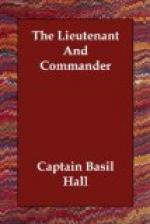it, a “school” of porpoises, are round
the ship. There is another favourite station
which is speedily filled on these occasions; I mean,
alongside of the slight-looking apparatus projecting
perpendicularly downwards from the end of the bowsprit.
This spar is not inaptly called the dolphin-striker,
from its appearing to dash into the waves as the ship
pitches; perhaps it may have acquired its name on
account of its being so capital a position from which
to strike that fish. The lower end of the spar
is connected with the outer end of the jib-boom, by
means of a stout rope, which, after passing through
its extremity, extends to the ship; and it is upon
this guy that the fortunate wielder of the harpoon
fixes himself. The harpoon is a triangular, or
rather a heart-shaped barbed weapon, somewhat larger
than a man’s head, and in the centre about as
thick as his knuckles. Its point and edges are
made of iron so soft that they can easily be brought
to a rough edge by means of a file. This javelin-head,
or, as it is technically called by whalers, the “mouth,”
is connected by a slender arm or shank, terminating
in a socket. The barbed head or mouth is eight
inches long, and six broad; the shank, with its socket,
two feet and a-half long. The shank is not quite
half an inch in diameter; and as this part is liable
to be forcibly extended, twisted, and bent, it requires
to be made of the toughest and most pliable iron.
A piece of small, but stout line, called, I think,
the foreganger, is spliced securely to the shank of
the harpoon. To the end of this line is attached
any small rope that lies handiest on the forecastle,
probably the top-gallant clew-line, or the jib down-haul.
The rope, before being made fast to the foreganger,
is rove through a block attached to some part of the
bowsprit, or to the foremost swifter of the fore-rigging;
a gang of hands are always ready to take hold of the
end, and run the fish right out of the water when pierced
by the iron.
The harpooner has nothing to attend to but the mere
act of striking his object; and there are few exploits
in which the dexterity of one person is more conspicuous
over that of another than in delivering the harpoon.
I have heard Captain Scoresby say, that, when a whale
is struck, it is an object of importance to drive
the weapon socket-deep into the blubber, or outer
rind, of the floating monster; but in the case of
the porpoise the true point of skill appears to lie
in the aim alone: for the mere weight of the
instrument, with its loaded staff, is sufficient to
lodge the barbs in the body of the fish, and in many
cases to carry it right through to the other side.




